
|
Painted Desert SheepThe Painted Desert Sheep is a spotted hair sheep that received most of its influence from the Mouflon. Before being established as a separate breed, it was considered by many to be a parti-colored Corsican. Other early influence came from Merino and Rambouillet, and a few four-horned individuals stem from Jacob or Churro ancestry. Long desired by hunters because of the large horns and aesthetic, flashy looks, the Painted Desert is now popular among exotic and alternative livestock fanciers. |

|
Panama SheepThe Panama breed of sheep is one of only two recognized breeds of sheep which were developed in the United States by private sheep breeders. Originating in Idaho in the early 1900's, the Panama began as a cross between Rambouillet rams and Lincoln ewes. Following approximately five years of crossbreeding, rams and ewes were mated among themselves to establish the breed. |
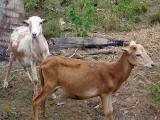
|
Pelibüey SheepThe Pelibüey is a hair sheep, probably closely related to the West African, Red African, African or Africana breed of Columbia and Venezuela. It is descended from the West African Dwarf and is found in Cuba, coastal areas of Mexico, and other locales in the Caribbean. It comprises 75 percent of sheep population in Cuba. |

|
Perendale SheepThe Perendale was developed in New Zealand during the 1950's at Massey University to meet the needs of hill country farmers on developing country. It is still a very popular breed in New Zealand. Developed from the Cheviot and Romney, the Perendale is a dual-purpose sheep producing a 28-32 micron wool with a 125 mm (5 in) staple length. |
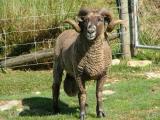
|
Pitt Island SheepThe Chatham Islands, inhabited by about 50 people, lie about 750 kilometers (469 miles) east of the Mainland of New Zealand. In 1841, Saxony Merino sheep were introduced to the Island. They have been untended for about 80 years. Natural selection has resulted in self-shedding fleeces and natural parasite resistance. Originally, they were all white. Half were black by 1950. |
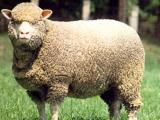
|
Polish Merino SheepThe first Merino sheep were introduced to Poland from Spain in 1786. In the early 19th centural, Electoral Merinos were imported. After 1860, Merinos of the Rambouillet and Precoce types were brought to Poland, and work towards a dual-purpose type of sheep was begun. In the period between 1918 and 1939, the breed was improved for meat traits using such breeds as the Mele and Ile de France, created on the basis of English Longwool sheep. |
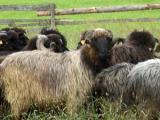
|
Polish Mountain SheepPolish Mountain Sheep evolved from the old Carpathian Cakiel, and especially one of its varieties - the primative Podhale sheep. The breed can be found in the whole Polish part of the Carpathian mountains; however, it is most frequently found in the Podhale region near the town of Nowy Sacz, where the breed traditionally originates. It has a light build, thin but strong legs and narrow rump. |

|
Polwarth SheepThe Polwarth is a dual-purpose sheep, developed in Victoria, Australia, in 1880. It is 75 percent Merino and 25 percent Lincoln. Polwarths are well suited to areas with improved pastures and are mainly found in the higher rainfall districts of southern Australia. The breed has been successfully exported to many countries, particularly South America where they are know as "Ideals". |

|
Polypay SheepThe Polypay is a synthetic breed, developed in the 1970's at the U.S. Sheep Experiment Station in Dubois, Idaho, and Nicholas Farms at Sonoma, California. Targhee x Dorset and Rambouillet x Finnsheep crosses were mated to form a 4-breed composite that could produce two lamb crops and one wool crop per year. |

|
Pomeranian Coarsewool SheepThe Pomeranian Coarsewool is a landrace sheep that used to be kept in small flocks along the Baltic Sea in Pomeranian (Pomerania) and Mecklenburg for its wool, meat, and milk. The Pomeranian are highly resistant against parasites. They are not fussy eaters, thrive on sandy, as well as moory ground and can be kept alone or in small flocks. They attach themselves to people, are hardy and not demanding. |
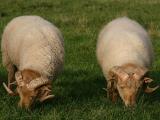
|
Portland SheepThe Portland, once common in Dorset, is now one of England's rarest breeds. It is most likely that the Portland is all that is left of the Western Tanfaced horn, common in the Southwest during the Middle Ages.The Portland was one of the breeds used in the development of the Dorset breed. Portlands are small. They are free of wool on the face and lower legs, which are tan. |

|
Priangan SheepIn the Priangan residency of West Java which includes the five districts of Bandung, Garut, Sumedang, Ciamis and Tasikmalaya, there is a breed of sheep which has been developed primarily for ram fighting (Ketangkasan Seni Domba). The rams are selected for size, horn size, and for fighting ability. The champion rams are highly priced and may fetch up to 300,000 rupiah (US$ 1 = 415 rupiah). However, they are not used for breeding during their fighting career as it is feared that mating would deprive them of their taste for fighting. |